Spatial Prediction of Soil Organic Matter Using a Hybrid Geostatistical Model of an Extreme Learning Machine and Ordinary Kriging
Abstract
:1. Introduction
2. Materials and Methods
2.1. Study Area
2.2. Soil Sampling and Analysis
2.3. Auxiliary Variables
2.4. Dimension-Reduced Processing
2.5. Modeling MLR, ANN and ELM
2.6. Hybrid Geostatistical Methods
2.7. Accuracy Evaluation of Prediction Performance
3. Results
3.1. Descriptive Statistics
3.2. SLR-PCA Analysis of Auxiliary Variables
3.3. Prediction of SOM Content by MLR, ANN and ELM Models
3.4. Spatial Prediction of SOM Content by Geostatistical Methods
3.5. Spatial Prediction of SOM Content by Hybrid Geostatistical Methods
4. Discussion
4.1. Driving Force Analysis of Auxiliary Variables for SOM
4.2. Sustainable Monitoring of Digital Mapping for SOM
5. Conclusions
Acknowledgments
Author Contributions
Conflicts of Interest
References
- Manlay, R.; Feller, C.; Swift, M. Historical evolution of soil organic matter concepts and their relationships with the fertility and sustainability of cropping systems. Agric. Ecosyst. Environ. 2007, 119, 217–233. [Google Scholar] [CrossRef]
- Brantley, S.L. Understanding soil time. Science 2008, 321, 1454–1455. [Google Scholar] [CrossRef] [PubMed]
- Lehmann, J.; Kleber, M. The contentious nature of soil organic matter. Nature 2015, 528, 60–68. [Google Scholar] [CrossRef] [PubMed]
- Zhao, Y.N.; He, X.H.; Huang, X.C.; Zhang, Y.Q.; Shi, X.J. Increasing soil organic matter enhances inherent soil productivity while offsetting fertilization effect under a rice cropping system. Sustainability 2016, 8, 879. [Google Scholar] [CrossRef]
- Jeffrey, D.S. Sustainable Development. Science 2004, 304, 649. [Google Scholar]
- Durigan, M.R.; Cherubin, M.R.; de Camargo, P.B.; Ferreira, J.N.; Berenguer, E.; Gardner, T.A.; Barlow, J.; Dias, C.T.D.S.; Signor, D.; Junior, R.C.D.O.; et al. Soil Organic Matter Responses to Anthropogenic Forest Disturbance and Land Use Change in the Eastern Brazilian Amazon. Sustainability 2017, 9, 379. [Google Scholar] [CrossRef]
- Sanchez, P.A.; Ahamed, S.; Carré, F.; Hartemink, A.E.; Hempel, J.; Huising, J.; Lagacherie, P.; Mcbratney, A.B.; Mckenzie, N.J.; Santos, M.L.D.M.; et al. Digital soil map of the world. Science 2009, 325, 680–681. [Google Scholar] [CrossRef] [PubMed]
- Guo, P.T.; Li, M.F.; Luo, W.; Tang, Q.F.; Liu, Z.W.; Lin, Z.M. Digital mapping of soil organic matter for rubber plantation at regional scale: An application of random forest plus residuals kriging approach. Geoderma 2015, 237–238, 49–59. [Google Scholar] [CrossRef]
- Meersmans, J.; Van Wesemael, B.; Goidts, E.; Van Molle, M.; De Baets, S.; De Ridder, F. Spatial analysis of soil organic carbon evolution in Belgian croplands and grasslands, 1960–2006. Glob. Chang. Biol. 2011, 17, 466–479. [Google Scholar] [CrossRef]
- Zhang, S.; Huang, Y.; Shen, C.; Ye, H.; Du, Y. Spatial prediction of soil organic matter using terrain indices and categorical variables as auxiliary information. Geoderma 2012, 171, 35–43. [Google Scholar] [CrossRef]
- Piccini, C.; Marchetti, A.; Francaviglia, R. Estimation of soil organic matter by geostatistical methods: Use of auxiliary information in agricultural and environmental assessment. Ecol. Indic. 2014, 36, 301–314. [Google Scholar] [CrossRef]
- Feng, C.; Kissel, D.E.; West, L.T.; Adkins, W. Field-scale mapping of surface soil organic carbon using remotely sensed imagery. Soil Sci. Soc. Am. J. 2000, 64, 746–753. [Google Scholar]
- Mirzaee, S.; Ghorbani-Dashtaki, S.; Mohammadi, J.; Asadi, H.; Asadzadeh, F. Spatial variability of soil organic matter using remote sensing data. Catena 2016, 145, 118–127. [Google Scholar] [CrossRef]
- Dai, F.; Zhou, Q.; Lv, Z.; Wang, X.; Liu, G. Spatial prediction of soil organic matter content integrating artificial neural network and ordinary kriging in Tibetan Plateau. Ecol. Indic. 2014, 45, 184–194. [Google Scholar] [CrossRef]
- Zhang, R.; Shouse, P.; Yates, S. Use of pseudo-crossvariograms and cokriging to improve estimates of soil solute concentrations. Soil Sci. Soc. Am. J. 1997, 61, 0361–5995. [Google Scholar] [CrossRef]
- Triantafilis, J.; Odeh, I.O.A.; Mcbratney, A.B. Five Geostatistical Models to Predict soil salinity from electromagnetic induction data across irrigated cotton. Soil Sci. Soc. Am. J. 2001, 65, 869–878. [Google Scholar] [CrossRef]
- Lark, R.M. Robust estimation of the pseudo cross-variogram for cokriging soil properties. Eur. J. Soil Sci. 2002, 53, 253–270. [Google Scholar] [CrossRef]
- Wu, C.F.; Wu, J.P.; Luo, Y.M.; Zhang, L.M.; Degloria, S.D. Spatial prediction of soil organic matter content using cokriging with remotely sensed data. Soil Sci. Soc. Am. J. 2009, 73, 1202–1208. [Google Scholar] [CrossRef]
- Mishra, U.; Lal, R.; Liu, D.S.; Meirvenne, M.V. Predicting the spatial variation of the soil organic carbon pool at a regional scale. Soil Sci. Soc. Am. J. 2010, 74, 906–914. [Google Scholar] [CrossRef]
- Marchetti, A.; Piccini, C.; Francaviglia, R.; Mabit, L. Spatial distribution of soil organic matter using geostatistics: A key indicator to assess soil degradation status in central Italy. Pedosphere 2012, 22, 230–242. [Google Scholar] [CrossRef]
- Hengl, T.; Heuvelink, G.B.M.; Rossiter, D.G. About regression-kriging: From equations to case studies. Comput. Geosci. 2007, 33, 1301–1315. [Google Scholar] [CrossRef]
- Zhao, Z.; Chow, T.L.; Rees, H.W.; Qi, Y.; Xing, Z.; Meng, F.R. Predict soil texture distributions using an artificial neural network model. Comput. Electron. Agric. 2009, 65, 36–48. [Google Scholar] [CrossRef]
- Cheng, X.F.; Shi, X.Z.; Yu, D.S.; Pan, X.Z.; Wang, H.J.; Sun, W.X. Using GIS spatial distribution to predict soil organic carbon in subtropical China. Pedosphere 2004, 14, 425–431. [Google Scholar]
- Odeha, I.O.A.; Mcbratney, A.B.; Chittleborough, D.J. Spatial prediction of soil properties from landform attributes derived from a digital elevation model. Geoderma 1994, 63, 197–214. [Google Scholar] [CrossRef]
- Kumar, S.; Lal, R.; Liu, D. A geographically weighted regression kriging approach for mapping soil organic carbon stock. Geoderma 2012, 189–190, 627–634. [Google Scholar] [CrossRef]
- Yang, Q.Y.; Jiang, Z.C.; Li, W.J.; Li, H. Prediction of soil organic matter in peak-cluster depression region using kriging and terrain indices. Soil Tillage Res. 2014, 144, 126–132. [Google Scholar] [CrossRef]
- Knotters, M.; Brus, D.J.; Voshaar, J.H.O. A comparison of kriging, co-kriging and kriging combined with regression for spatial interpolation of horizon depth with censored observations. Geoderma 1995, 67, 227–246. [Google Scholar] [CrossRef]
- Li, Y. Can the spatial prediction of soil organic matter contents at various sampling scales be improved by using regression kriging with auxiliary information? Geoderma 2010, 159, 63–75. [Google Scholar] [CrossRef]
- Somaratne, S.; Seneviratne, G.; Coomaraswamy, U. Prediction of soil organic carbon across different land-use patterns. Soil Sci. Soc. Am. J. 2005, 69, 1580–1589. [Google Scholar] [CrossRef]
- Zhao, Z.Y. Using artificial neural network models to produce soil organic carbon content distribution maps across landscapes. Can. J. Soil Sci. 2010, 90, 75–87. [Google Scholar] [CrossRef]
- Li, Q.Q.; Yue, T.X.; Wang, C.Q.; Zhang, W.J.; Yu, Y.; Li, B. Spatially distributed modeling of soil organic matter across China: An application of artificial neural network approach. Catena 2013, 104, 210–218. [Google Scholar] [CrossRef]
- Huang, G.B.; Zhu, Q.Y.; Siew, C.K. Extreme learning machine: A new learning scheme of feedforward neural networks. IEEE Int. Jt. Conf. Neural Netw. 2004, 2, 985–990. [Google Scholar]
- Huang, G.; Huang, G.B.; Song, S.; You, K. Trends in extreme learning machines: A review. Neural Netw. 2014, 61, 32–48. [Google Scholar] [CrossRef] [PubMed]
- Ding, S.; Zhao, H.; Zhang, Y.; Xu, X.; Nie, R. Extreme learning machine: Algorithm, theory and applications. Artif. Intell. Rev. 2013, 44, 103–115. [Google Scholar] [CrossRef]
- Liu, X.; Lin, S.; Fang, J.; Xu, Z. Is extreme learning machine feasible? A theoretical assessment (Part II). IEEE Trans. Neural Netw. Learn. Syst. 2014, 26, 7–20. [Google Scholar] [CrossRef] [PubMed]
- Deng, C.W.; Huang, G.B.; Jia, X.U.; Tang, J.X. Extreme learning machines: New trends and applications. Sci. China Inf. Sci. 2015, 58, 1–16. [Google Scholar] [CrossRef]
- The Ministry of Agriculture of the People’s Republic of China. Rules for Soil Quality Survey and Assessment (NY/T 1634-2008). 2008. Available online: http://www.moa.gov.cn/ (accessed on 5 November 2016). (In Chinese)
- The Ministry of Agriculture of the People’s Republic of China. Chinese Agriculture Industry Standard (NY/T 1211.1-2006). 2006. Available online: http://www.moa.gov.cn/ (accessed on 5 November 2016). (In Chinese)
- Read, J.W.; Ridgell, R.H. On the use of the conventional carbon factor in estimating soil organic matter. Soil Sci. 1922, 13, 1–6. [Google Scholar] [CrossRef]
- Nelson, D.W.; Sommers, L.E. A rapid and accurate method for estimating organic carbon in the soil. Proc. Indiana Acad. Sci. 1975, 84, 456–462. [Google Scholar]
- The National Aeronautics and Space Agency (NASA). Available online: http://landsat.usgs.gov/ (accessed on 1 December 2016).
- Huete, A.R.; Liu, H.Q. An error and sensitivity analysis of the atmospheric- and soil-correcting variants of the NDVI for the MODIS-EOS. IEEE Trans. Geosci. Remote Sens. 1994, 32, 897–905. [Google Scholar] [CrossRef]
- International Scientific & Technical Data Mirror Site, Computer Network Information Center, Chinese Academy of Sciences. Available online: http://www.gscloud.cn/ (accessed on 2 December 2016). (In Chinese).
- Zhang, B.C.; Zhang, Y.M.; Zhao, J.C.; Wu, N.; Chen, R.Y.; Zhang, J. Microalgal species variation at different successional stages in biological soil crusts of the Gurbantunggut Desert, Northwestern China. Biol. Fertil. Soils 2009, 45, 539–547. [Google Scholar] [CrossRef]
- Pirie, A.; Singh, B.; Islam, K. Ultra-violet, visible, near-infrared, and mid-infrared diffuse reflectance spectroscopic techniques to predict several soil properties. Soil Res. 2005, 43, 713–721. [Google Scholar] [CrossRef]
- Razakamanarivo, R.H.; Grinand, C.; Razafindrakoto, M.A.; Bernoux, M.; Albrecht, A. Mapping organic carbon stocks in eucalyptus plantations of the central highlands of Madagascar: A multiple regression approach. Geoderma 2011, 162, 335–346. [Google Scholar] [CrossRef]
- Malone, B.P.; Styc, Q.; Minasny, B.; Mcbratney, A.B. Digital soil mapping of soil carbon at the farm scale: A spatial downscaling approach in consideration of measured and uncertain data. Geoderma 2017, 290, 91–99. [Google Scholar] [CrossRef]
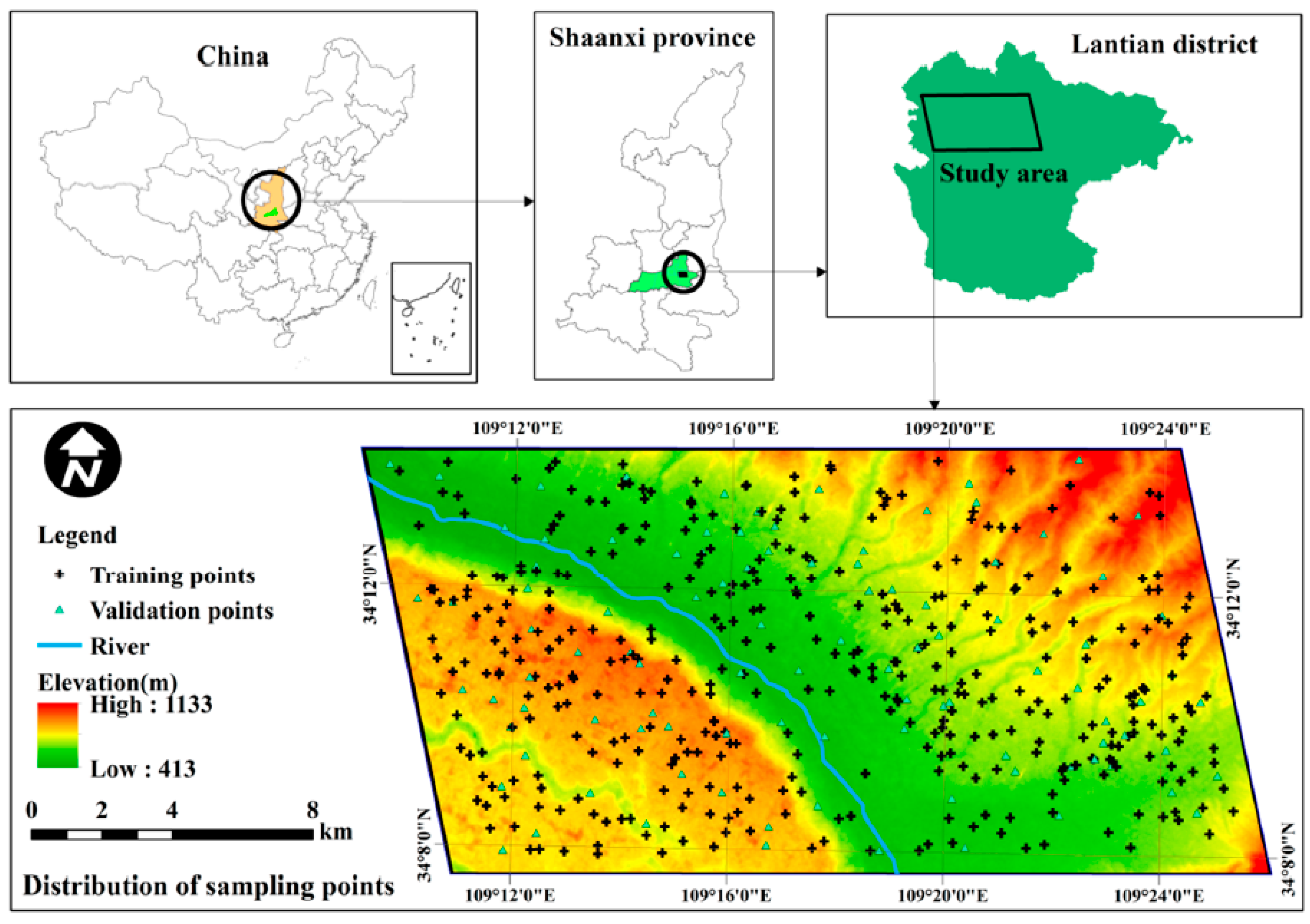
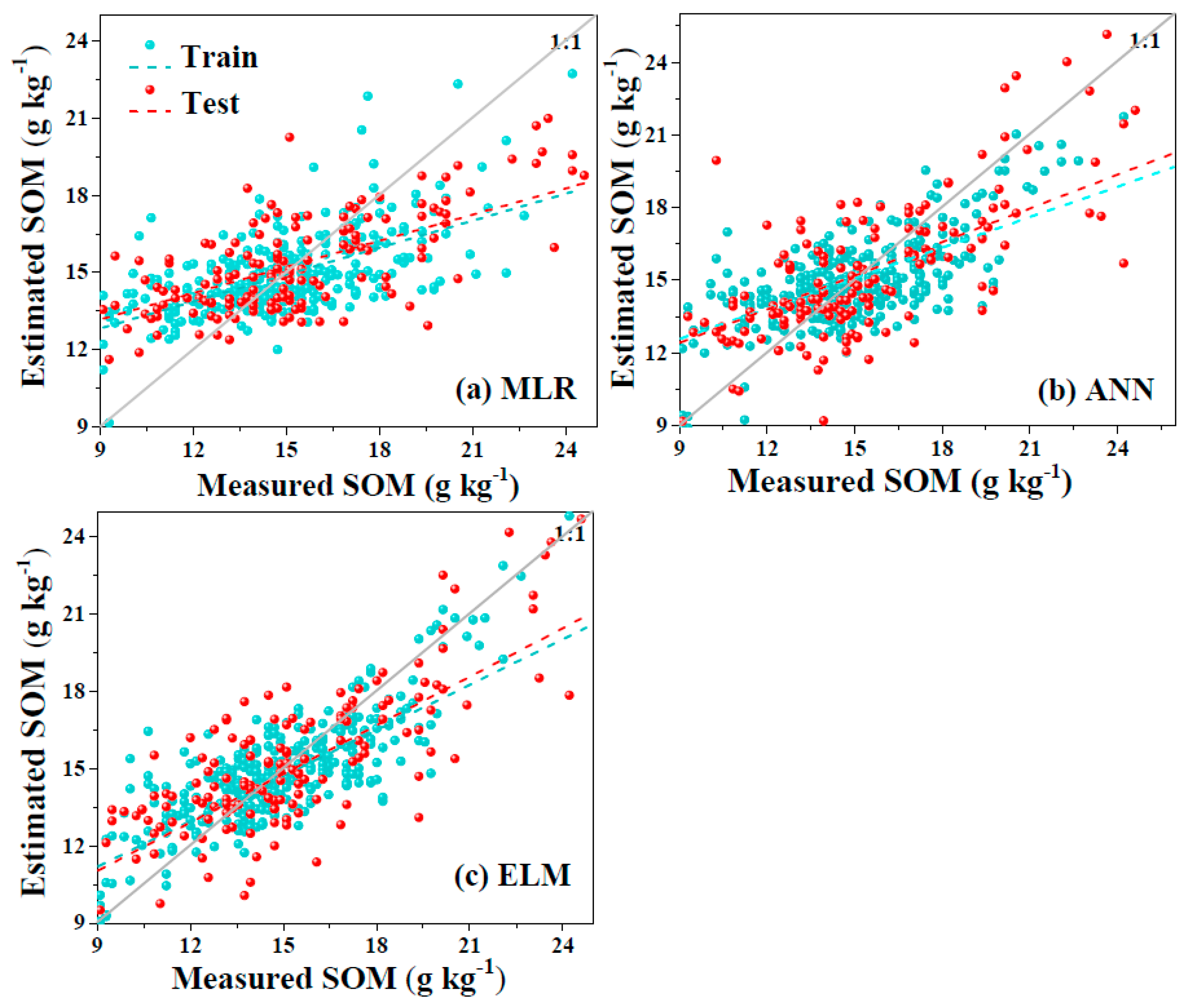
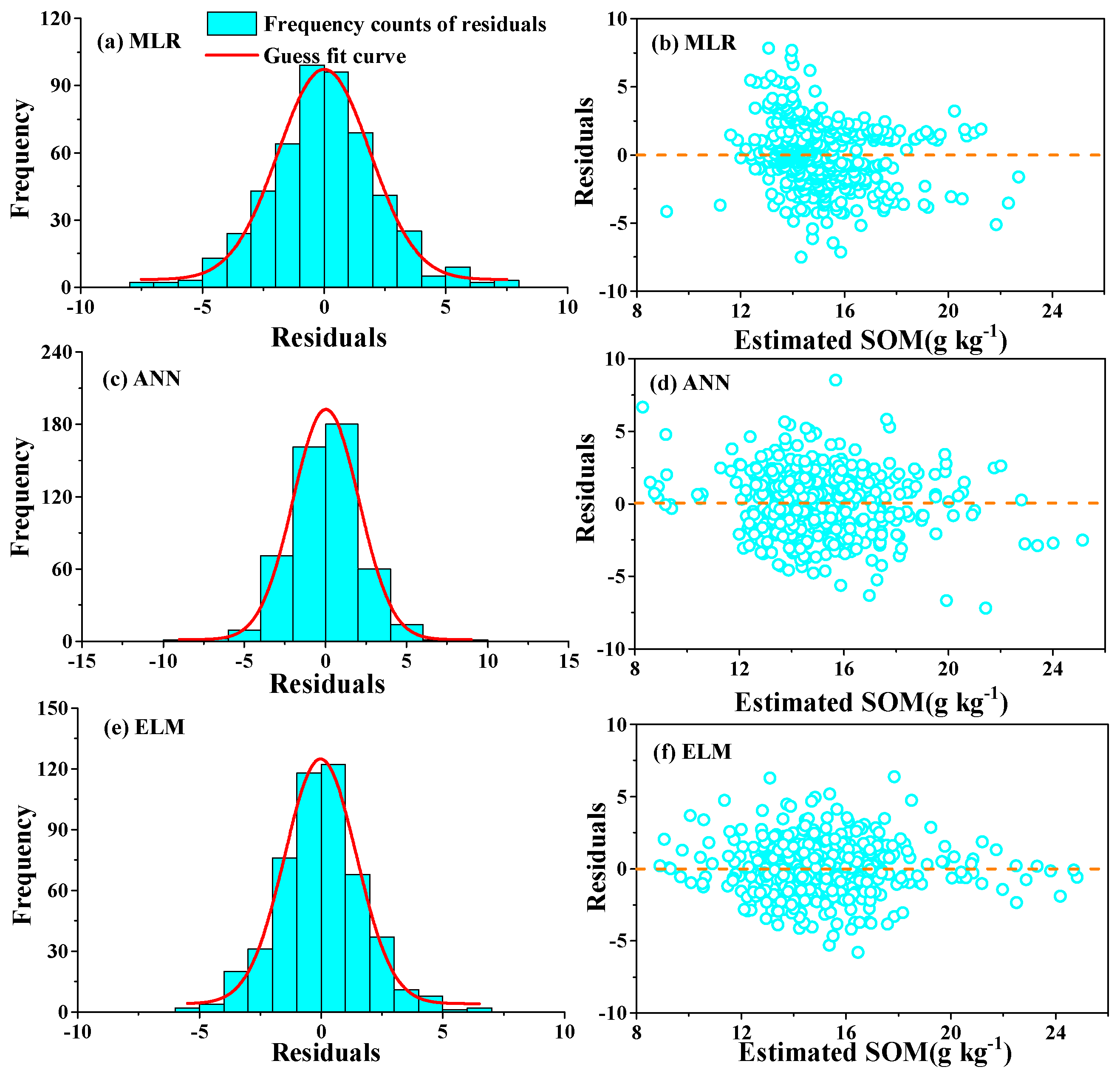
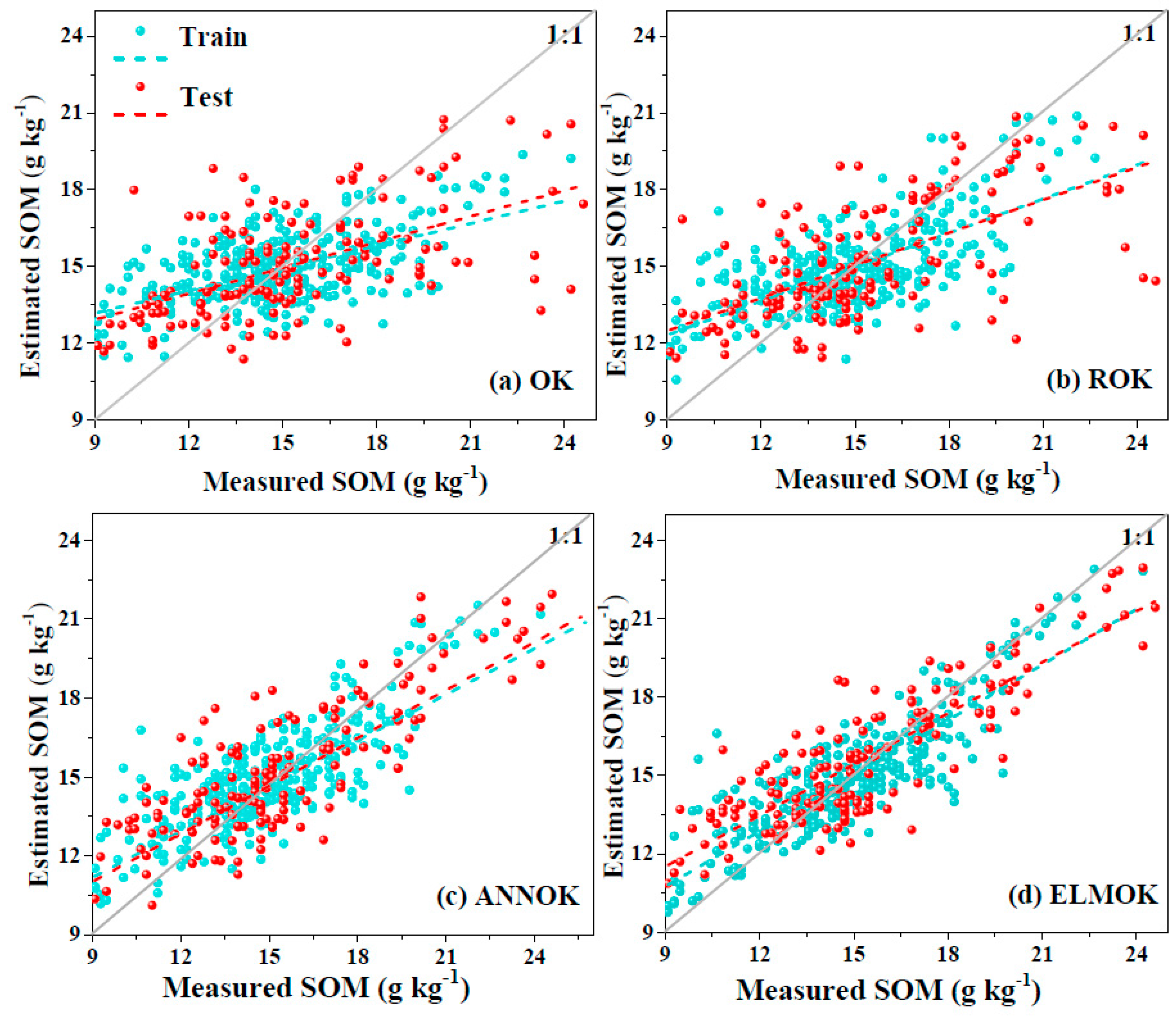
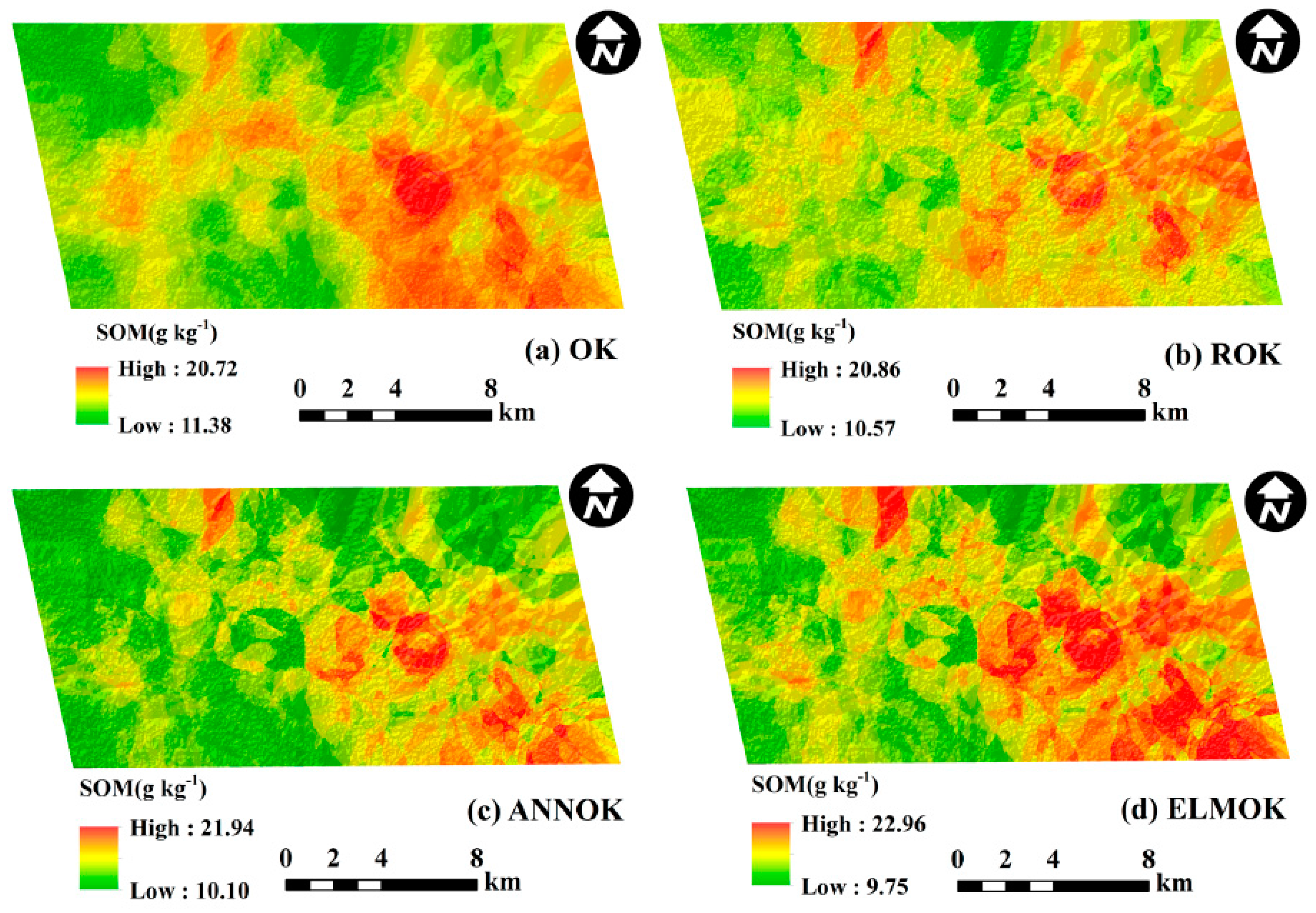

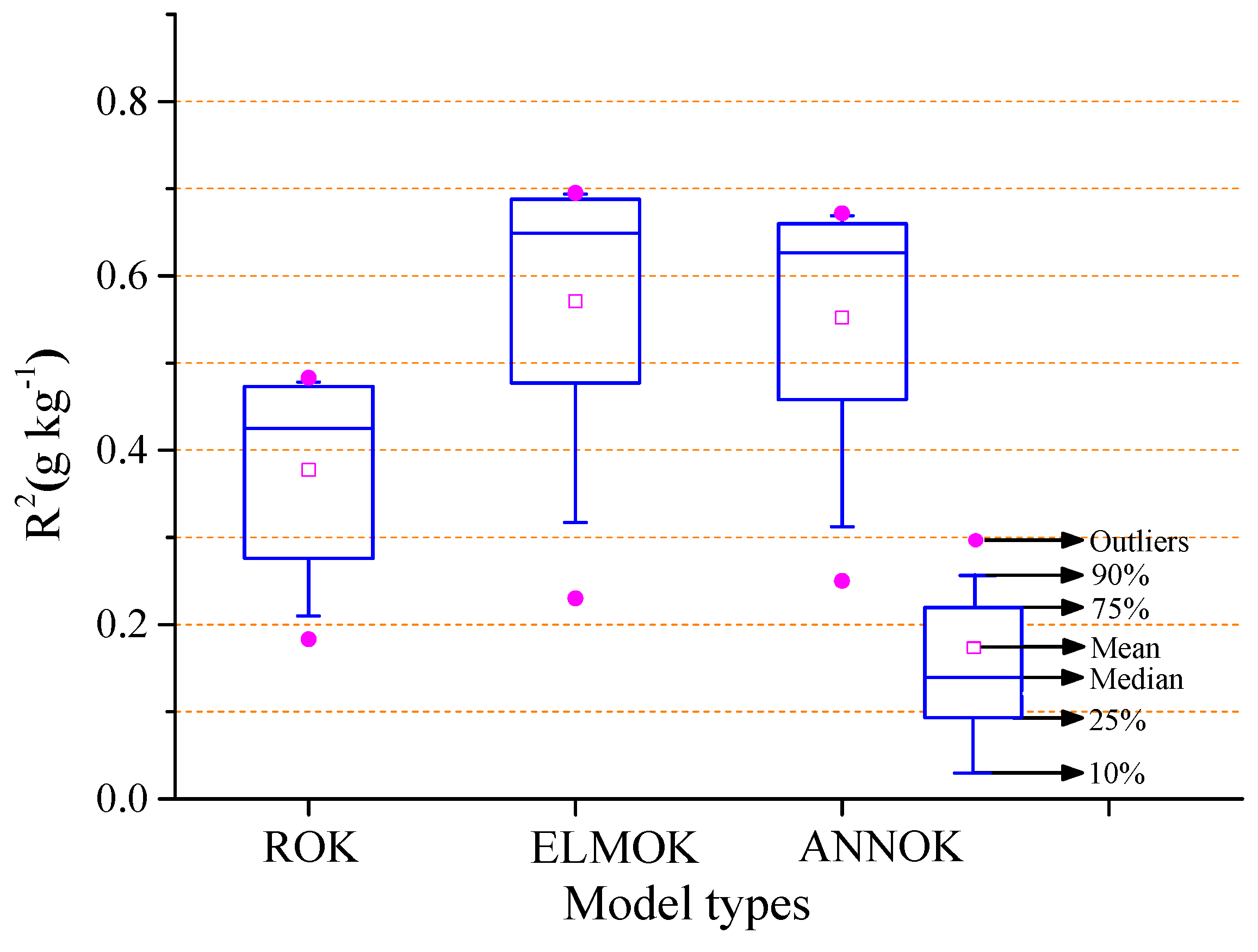
| SOM and Auxiliary Variables | Units | Minimum | Maximum | Mean | Std.Dev. | CV (%) |
|---|---|---|---|---|---|---|
| SOM | g kg−1 | 9.10 | 24.61 | 15.02 | 2.87 | 19.11 |
| Band 2 | Dimensionless | 111.70 | 1036.60 | 492.18 | 147.18 | 29.90 |
| Band 3 | Dimensionless | 139.52 | 1253.33 | 692.67 | 201.97 | 29.16 |
| Band 4 | Dimensionless | 150.62 | 1632.99 | 887.66 | 268.397 | 30.24 |
| Band 5 | Dimensionless | 237.27 | 3042.71 | 1767.31 | 540.87 | 30.60 |
| Band 6 | Dimensionless | 287.53 | 3039.49 | 1851.88 | 493.741 | 26.66 |
| Band 7 | Dimensionless | 217.11 | 2598.27 | 1557.97 | 436.452 | 28.01 |
| NDVI | Dimensionless | 0.05 | 0.66 | 0.32 | 0.11 | 34.38 |
| ELE | m | 440.00 | 885.00 | 623.58 | 96.23 | 15.43 |
| SLO | ° | 2.00 | 68.67 | 17.68 | 12.08 | 68.33 |
| ASP | Dimensionless | 5.31 | 350.92 | 182.48 | 86.63 | 47.47 |
| REL | m | 2.00 | 39.00 | 10.52 | 6.17 | 58.65 |
| PREC | mm | 47.67 | 54.58 | 51.36 | 1.40 | 2.73 |
| TMEAN | °C | 23.40 | 26.10 | 24.87 | 0.60 | 2.41 |
| pH | Dimensionless | 6.80 | 8.90 | 7.35 | 0.24 | 3.27 |
| Auxiliary Variables | PC1 | PC2 | PC3 |
|---|---|---|---|
| B4 | 0.75 | 0.64 | 0.13 |
| B6 | 0.74 | 0.60 | −0.07 |
| B7 | 0.71 | 0.60 | 0.29 |
| NDVI | −0.17 | −0.31 | 0.73 |
| ELE | −0.71 | 0.64 | −0.01 |
| ASP | −0.20 | 0.02 | 0.64 |
| PREC | −0.69 | 0.66 | 0.017 |
| TMEAN | 0.73 | −0.66 | 0.013 |
| Eigenvalue | 3.21 | 2.51 | 1.05 |
| Variance explained (%) | 40.14 | 31.34 | 13.13 |
| Cumulative variance (%) | 40.14 | 71.48 | 84.60 |
| Training Data Set | Testing Data Set | D-W a | |||||
|---|---|---|---|---|---|---|---|
| ME (g kg−1) | RMSE (g kg−1) | R2 | ME (g kg−1) | RMSE (g kg−1) | R2 | ||
| MLR | 11.32 | 2.19 | 0.317 | 12.53 | 2.25 | 0.292 | 1.651 |
| Methods | Selected Architecture a | Training Data Set | Testing Data Set | Run Time (s) | ||||
|---|---|---|---|---|---|---|---|---|
| ME (g kg−1) | RMSE (g kg−1) | R2 | ME (g kg−1) | RMSE (g kg−1) | R2 | |||
| ANN | 3-26-1 | 9.04 | 1.766 | 0.476 | 8.56 | 1.692 | 0.491 | 52 |
| ELM | 3-23-1 | 7.16 | 1.618 | 0.561 | 6.93 | 1.531 | 0.583 | 160 |
| Variogram | Model | Range (km) | Nugget | Sill | Nugget/Sill |
|---|---|---|---|---|---|
| Semivariograms of SOM | Exponential | 4.57 | 0.031 | 0.115 | 0.270 |
| Residuals of MLR | Exponential | 3.34 | 0.345 | 0.979 | 0.352 |
| Residuals of ANN | Exponential | 3.60 | 0.503 | 1.166 | 0.431 |
| Residuals of ELM | Exponential | 3.06 | 0.478 | 1.213 | 0.394 |
| Interpolation Methods | ME (g kg−1) | RMSE (g kg−1) | R2 | RPD |
|---|---|---|---|---|
| SK | 15.95 | 3.26 | 0.192 | 0.88 |
| OK | 11.05 | 2.071 | 0.363 | 1.39 |
| ROK | 9.97 | 1.974 | 0.422 | 1.45 |
| ANNOK | 6.22 | 1.463 | 0.611 | 1.96 |
| ELMOK | 5.37 | 1.402 | 0.671 | 2.05 |
© 2017 by the authors. Licensee MDPI, Basel, Switzerland. This article is an open access article distributed under the terms and conditions of the Creative Commons Attribution (CC BY) license (http://creativecommons.org/licenses/by/4.0/).
Share and Cite
Song, Y.-Q.; Yang, L.-A.; Li, B.; Hu, Y.-M.; Wang, A.-L.; Zhou, W.; Cui, X.-S.; Liu, Y.-L. Spatial Prediction of Soil Organic Matter Using a Hybrid Geostatistical Model of an Extreme Learning Machine and Ordinary Kriging. Sustainability 2017, 9, 754. https://doi.org/10.3390/su9050754
Song Y-Q, Yang L-A, Li B, Hu Y-M, Wang A-L, Zhou W, Cui X-S, Liu Y-L. Spatial Prediction of Soil Organic Matter Using a Hybrid Geostatistical Model of an Extreme Learning Machine and Ordinary Kriging. Sustainability. 2017; 9(5):754. https://doi.org/10.3390/su9050754
Chicago/Turabian StyleSong, Ying-Qiang, Lian-An Yang, Bo Li, Yue-Ming Hu, An-Le Wang, Wu Zhou, Xue-Sen Cui, and Yi-Lun Liu. 2017. "Spatial Prediction of Soil Organic Matter Using a Hybrid Geostatistical Model of an Extreme Learning Machine and Ordinary Kriging" Sustainability 9, no. 5: 754. https://doi.org/10.3390/su9050754
APA StyleSong, Y.-Q., Yang, L.-A., Li, B., Hu, Y.-M., Wang, A.-L., Zhou, W., Cui, X.-S., & Liu, Y.-L. (2017). Spatial Prediction of Soil Organic Matter Using a Hybrid Geostatistical Model of an Extreme Learning Machine and Ordinary Kriging. Sustainability, 9(5), 754. https://doi.org/10.3390/su9050754







